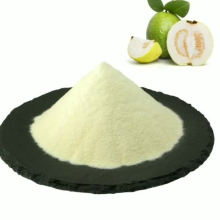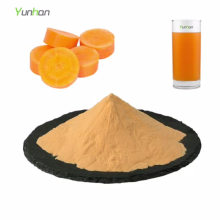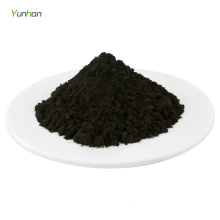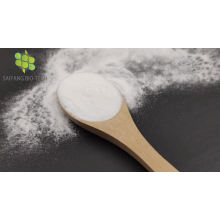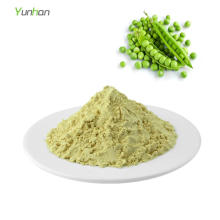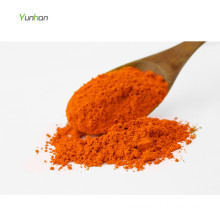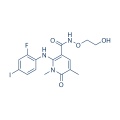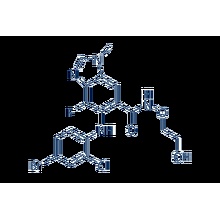AZD8330 869357-68-6
Product Description
.cp_wz table {border-top: 1px solid #ccc;border-left:1px solid #ccc; } .cp_wz table td{border-right: 1px solid #ccc; border-bottom: 1px solid #ccc; padding: 5px 0px 0px 5px;} .cp_wz table th {border-right: 1px solid #ccc;border-bottom: 1px solid #ccc; padding: 5px 0px 0px 5px;}
Molecular Weight:
461.23 AZD8330 is a novel, selective, non-ATP competitive MEK 1/2 inhibitor with IC50 of 7 nM. Phase 1.
Biological Activity
AZD8330 potently and strongly inhibits MEK 1/2. AZD8330 has no
inhibitory activity against over 200 other kinases including at
concentrations up to 10 μM. AZD8330 demonstrates sub-nanomolar potency
in mechanistic (pERK) and low to sub-nanomolar potency in functional
(proliferation) assays in MEK 1/2 inhibitor sensitive cell lines.
In a Calu-6 rat xenograft pharmacokinetic/pharmacodynamic (PK/PD) model a
single, 1.25 mg/kg oral dose of AZD8330 inhibits ERK phosphorylation by
> 90% for between 4 and 8 hours. Doses as low as 0.4 mg/kg once
daily are sufficient for > 80% tumor growth inhibition in the Calu-6
nude rat xenograft model. In the Calu-6 model, AZD8330 inhibits tumor
growth in a dose-dependent fashion, at 0.3 mg/kg and 1.0 mg/kg once
daily.
Protocol(Only for Reference)
Kinase Assay: [2]
Cell Assay: [1]
Animal Study: [1]
Conversion of different model animals based on BSA (Value based on data from FDA Draft Guidelines)
For example, to modify the dose of resveratrol used for a mouse (22.4 mg/kg) to a dose based on the BSA for a rat, multiply 22.4 mg/kg by the Km factor for a mouse and then divide by the Km factor for a rat. This calculation results in a rat equivalent dose for resveratrol of 11.2 mg/kg.
Chemical Information
Molarity Calculator
Dilution Calculator
Molecular Weight Calculator
Contact us if you need more details on 869357-68-6. We are ready to answer your questions on packaging, logistics, certification or any Other aspects about AZD8330 869357-68-6、869357-68-6 AZD8330. If these products fail to match your need, please contact us and we would like to provide relevant information.
Molecular Weight:
461.23 AZD8330 is a novel, selective, non-ATP competitive MEK 1/2 inhibitor with IC50 of 7 nM. Phase 1.
Biological Activity
AZD8330 potently and strongly inhibits MEK 1/2. AZD8330 has no
inhibitory activity against over 200 other kinases including at
concentrations up to 10 μM. AZD8330 demonstrates sub-nanomolar potency
in mechanistic (pERK) and low to sub-nanomolar potency in functional
(proliferation) assays in MEK 1/2 inhibitor sensitive cell lines.
In a Calu-6 rat xenograft pharmacokinetic/pharmacodynamic (PK/PD) model a
single, 1.25 mg/kg oral dose of AZD8330 inhibits ERK phosphorylation by
> 90% for between 4 and 8 hours. Doses as low as 0.4 mg/kg once
daily are sufficient for > 80% tumor growth inhibition in the Calu-6
nude rat xenograft model. In the Calu-6 model, AZD8330 inhibits tumor
growth in a dose-dependent fashion, at 0.3 mg/kg and 1.0 mg/kg once
daily.
Protocol(Only for Reference)
Kinase Assay: [2]
| MEK1 enzymatic assays | NH2-terminal hexahistidine tagged, constitutively active MEK1 (S218D, S222D ΔR4F) is expressed in baculovirus-infected Hi5 insect cells and purified by immobilized metal affinity chromatography, ion exchange, and gel filtration. The activity of MEK1 is assessed by measuring the incorporation of [γ- 33P]phosphate from [γ-33P]ATP onto ERK2. The assay is carried out in a 96-well polypropylene plate with an incubation mixture (100 μL) composed of 25 mM HEPES (pH 7.4), 10 mM MgCl2, 5 mM β-glycerolphosphate, 100 μM sodium orthovanadate, 5 mM DTT, 5 nM MEK1, 1 μM ERK2, and 0 to 80 nM AZD8330 (final concentration of 1% DMSO). The reactions are initiated by the addition of 10 μM ATP (with 0.5 μC k[γ-33P]ATP/well) and incubated at room temperature for 45 min. An equal volume of 25% trichloracetic acid is added to stop the reaction and precipitate the Proteins. Precipitated proteins are trapped onto glass fiber B filter plates, excess labeled ATP is washed off with 0.5% phosphoric acid, and radioactivity is counted in a liquid scintillation counter. ATP dependence is determined by varying the amount of ATP in the reaction mixture. The data are globally fitted. |
|---|
Cell Assay: [1]
| Cell lines | Malme-3M melanoma cells |
|---|---|
| Concentrations | ~10 μM |
| Incubation Time | 1 hour |
| Method | Malme-3M melanoma cells are plated in 96-wells and treated with various concentrations of AZD8330 for 1 hour at 37 °C. The cells are fixed, permeabilized, and incubated with an anti-phospho-ERK antibody and an anti-ERK 1/2 antibody. Plates are washed and fluorescently-labeled secondary antibodies are added. Plates are analyzed on a LICOR fluorescence imager. The pERK signal is normalized to the total ERK signa |
Animal Study: [1]
| Animal Models | Female nude rats (NIH rnu/rnu) with Calu-6 cells, nude rats with SW620 cells | ||
|---|---|---|---|
| Formulation | 0.5% HPMC-0.1% Tween | ||
| Dosages | 0.3 mg/kg, 1 mg/kg | ||
| Administration | Oral administration | ||
| Solubility | 0.5% hydroxyethyl cellulose/0.1% Tween 80, 30 mg/mL | ||
| * Please note that Selleck tests the solubility of all compounds in-house, and the actual solubility may differ slightly from published values. This is normal and is due to slight batch-to-batch variations. | |||
Conversion of different model animals based on BSA (Value based on data from FDA Draft Guidelines)
| Species | Baboon | Dog | Monkey | Rabbit | Guinea pig | Rat | Hamster | Mouse |
| Weight (kg) | 12 | 10 | 3 | 1.8 | 0.4 | 0.15 | 0.08 | 0.02 |
| Body Surface Area (m2) | 0.6 | 0.5 | 0.24 | 0.15 | 0.05 | 0.025 | 0.02 | 0.007 |
| Km factor | 20 | 20 | 12 | 12 | 8 | 6 | 5 | 3 |
| Animal A (mg/kg) = Animal B (mg/kg) multiplied by | Animal B Km |
| Animal A Km |
For example, to modify the dose of resveratrol used for a mouse (22.4 mg/kg) to a dose based on the BSA for a rat, multiply 22.4 mg/kg by the Km factor for a mouse and then divide by the Km factor for a rat. This calculation results in a rat equivalent dose for resveratrol of 11.2 mg/kg.
| Rat dose (mg/kg) = mouse dose (22.4 mg/kg) × | mouse Km(3) | = 11.2 mg/kg |
| rat Km(6) |
Chemical Information
| Molecular Weight (MW) | 461.23 |
|---|---|
| Formula | C16H17FIN3O4 |
| CAS No. | 869357-68-6 |
| Storage | 3 years -20℃Powder |
|---|---|
| 6 months-80℃in solvent (DMSO, water, etc.) | |
| Synonyms | ARRY704 |
| Solubility (25°C) * | In vitro | DMSO | 92 mg/mL (199.46 mM) |
|---|---|---|---|
| Water | <1 mg/mL ( | ||
| Ethanol | 92 mg/mL (199.46 mM) | ||
| In vivo | 0.5% hydroxyethyl cellulose/0.1% Tween 80 | 30 mg/mL | |
| * <1 mg/ml means slightly soluble or insoluble. * Please note that Selleck tests the solubility of all compounds in-house, and the actual solubility may differ slightly from published values. This is normal and is due to slight batch-to-batch variations. | |||
| Chemical Name | 2-(2-fluoro-4-iodophenylamino)-N-(2-hydroxyethoxy)-1,5-dimethyl-6-oxo-1,6-dihydropyridine-3-carboxamide |
|---|
Molarity Calculator
Dilution Calculator
Molecular Weight Calculator
Contact us if you need more details on 869357-68-6. We are ready to answer your questions on packaging, logistics, certification or any Other aspects about AZD8330 869357-68-6、869357-68-6 AZD8330. If these products fail to match your need, please contact us and we would like to provide relevant information.
Product Categories : MAPK > MEK Inhibitor
Other Products
Hot Products
Astragaloside AChlortetracycline HCl 64-72-2Paclitaxel 33069-62-4Dexamethasone Acetate 1177-87-3Dinaciclib (SCH727965) 779353-01-4CHIR-124 405168-58-3Ro3280 1062243-51-9TAME 901-47-3CCG-1423 285986-88-110058-F4 403811-55-2Dabigatran (BIBR 953) 211914-51-1H 89 2HCl 130964-39-5T0901317 293754-55-9Aprepitant 170729-80-3Turofexorate Isopropyl (XL335) 629664-81-9BMS-378806 357263-13-9

